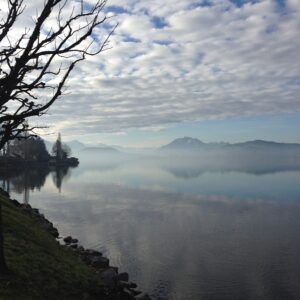(English below)
In dem Gebiet, das wir heute als Schweiz kennen, lebte bereits 450 v. Chr. ein hochgebildetes Volk: Die Kelten. Sie besiedelten das Gebiet der britischen Inseln, Frankreich, Nordspanien über Zentraleuropa bis hin nach Westungarn, Slowenien und Nordkroatien und gelten als erste Hochkultur in Europa. Da sie aus kultistischen Gründen nur der mündlichen Überlieferung vertrauten, sind nur schriftliche Dokumente ihrer Feinde, den Griechen und Römer, vorhanden. So stützt sich die Forschung hauptsächlich auf Funde, deren beachtliche Anzahl in der Schweiz auf die Wichtigkeit des Gebiets schliessen lässt. Von der Antike bis weit in die Neuzeit verlief die besten Transportrouten entlang der natürlichen Wasserwege, und so waren Uferzonen prädestinierte Siedlungsorte. Daher sind heutige Funde von Kelten in der Schweiz oft entlang Flüssen oder Seen lokalisiert.
Im 1. Jh. n. Chr. wurden die im Schweizer Gebiet herrschenden keltischen Stämme von Caesars Armee besiegt, doch um 600 n. Chr. kamen die ersten irischen Glaubensboten zurück in die Schweiz. Tatsächlich blieben die Kelten bis ins 16. Jahrhundert in Irland, während sie an allen anderen Orten verschwunden sind und nicht selten im Schatten der Griechen und Römer stehen. Dennoch gehören sie zum kulturellen Ursprung vieler europäischen Ländern, so auch der Schweiz. Als keltische Länder kennen wir heute Irland, Schottland, Wales, die Isle of Man und die Bretagne sowie Galizien (Nordspanien).

Die keltische Kultur war naturalistisch geprägt und hielt sich an einem Jahreskreis fest, der sich an den Zyklen von Sonne und Mond orientierte. Acht Festtage strukturieren das Jahr, welche noch heute Bestandteil unseres Jahreskalenders sind. Weihnachten zum Beispiel fällt auf den keltischen Festtag der Wintersonnenwende. Ein weiteres Beispiel ist unsere Walpurgisnacht am 1. Mai, welche bei den Kelten als Beltane (Sommerbeginn) gefeiert wurde. Das Pendant zur Wintersonnenwende ist die Sommersonnenwende am 21. Juni, die im christlichen Kalender als Johannisfeier übernommen wurde. Auch das nunmehr amerikanisierte Halloween Ende Oktober hat seine Ursprünge im keltischen Neujahr Samhain und markiert im christlichen Kalender das Fest der Allerheiligen.
Auch in Musik und Kultur hinterliessen die Kelten ihre Spuren. Das Volk setzte sich aus verschiedenen Stämmen zusammen, wurde aber vereint durch eine gemeinsame Sprache. Wie diese genau geklungen hat, ist unklar, doch das walisische Kymrisch, das Gälisch in Irland und Schottland sowie das Bretonisch in Frankreich geben davon ungefähre Vorstellungen. Gemäss einigen Forschenden hat auch das Schweizer Rätoromanisch keltische Wurzeln. Was die Musik angeht, so gibt es Theorien, dass die Ursprünge des alpenländischen Jodelns in der keltischen Kultur liegen. In den keltischen Ländern hat sich die Verweigerung der Schriftlichkeit bis heute gehalten: Alle Musik wird nach Gehör und nicht nach Notationen gespielt. Aufgrund der grossen Bedeutung der Mündlichkeit, sind die Kelten auch als meisterhafte Geschichtenerzähler bekannt.
(English Version)
In a region nowadays known as Switzerland already 450BC there was living a highly educated folk: The celts. They occupied the region of the British Isles, France, Northern Spain and all the way from central Europe to western Hungary, Slovenia and Northern Croatia and are thought to be the first advanced civilisation of Europe. For cultural reasons they only trusted oral tradition and therefore the only available written documents come from their enemies, namely the Greeks and the Romans. Most of the research about the celts is based on findings, out of which a notable number was made in Switzerland. This shows about the importance of the region. From ancient times far into the new age some of the best transport routes went along the natural water ways, which lead to littoral zones becoming places of settlement. This is why many of today’s findings of the Celts in Switzerland are located along rivers and lakes.

In the first century AD the dominant celtic tribes in the swiss region were defeated by Ceasars army, however around 600 AD the first Irish missionaries came back to Switzerland. The Celts stayed in Ireland until the 16th century whereas they disappeared in all other places, not seldom as a consequence of the dominance of the Romans and the Greeks. Nevertheless they form part of the cultural origin of many European countries, likewise Switzerland. Nowadays Ireland, Scottland, Wales, the Isle of Man and the Bretagne as well as Galicia are known as Celtic countries.
The Celtic culture was a naturalistic one and was tied to the wheel of the year, which oriented itself on the cycles of the sun and the moon. Eight holidays structured the year, which are still part of our calendar nowadays. Christmas for example coincides with the Celtic holiday of the winter solstice. Another example is the Walpurgis Night on the 1st of May which was celebrated as Beltane (the beginning of summer) among the Celts. The equivalent to the winter solstice is the summer solstice on the 21st of June, which in the Christian calendar has been taken over as Johannisfeier. Even the American Halloween which at the end of October has its roots in the Celtic New Year Samhain and marks the celebration of All Hallows.
The Celts also left their trances in music and culture. The people were composed of different tribes that were united through a common language. The exact sound of the language remains unclear, however the welsh Cymric, the Gaelic in Ireland and Scotland as well as the Breton in France give indications of what it must have sounded like. According to research even the Swiss Romansh has Celtic roots. When it comes to music there are theories that the origins of the alpine yodelling lie in the Celtic culture. In Celtic countries the refusal of keeping written track of things has been kept up until the present day: All music is being played by ear and not by notations. Because of the great importance of oral traditions it only makes sense that the Celts are renowned to be masterful storytellers.
